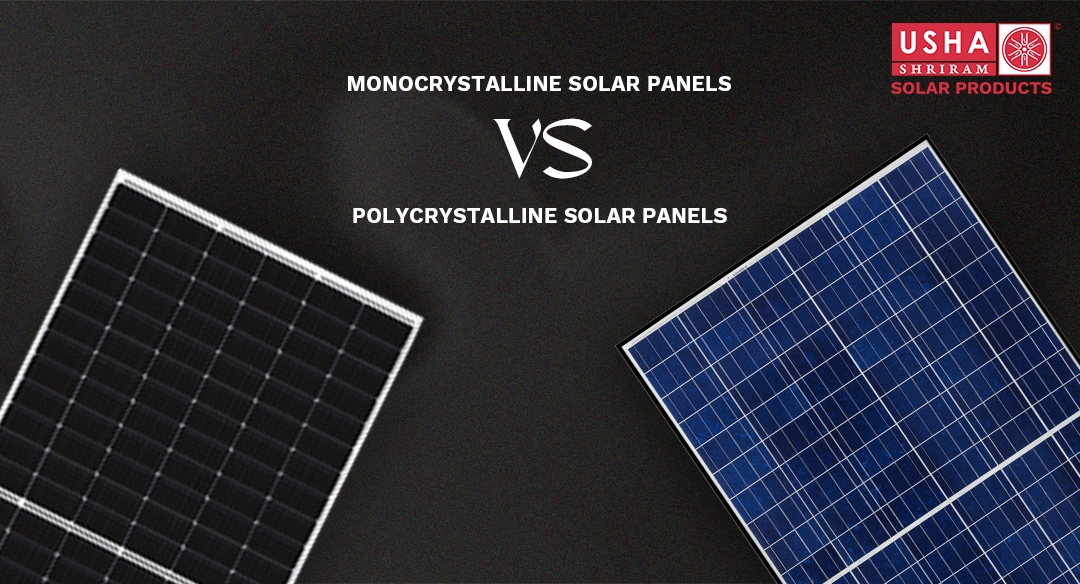Introduction
Solar energy is transforming India’s energy landscape, offering a clean, reliable, and cost-effective alternative to traditional electricity. But with so many options in Solar PV module, choosing between monocrystalline solar panels vs polycrystalline solar panels can feel overwhelming.
This blog will simplify the difference between monocrystalline and polycrystalline solar panels, covering efficiency, cost, space requirements, and environmental impact.
What Are Monocrystalline Solar Panels?
Monocrystalline solar panels are made from a single, pure silicon crystal. The silicon is shaped into a cylindrical ingot and sliced into thin wafers, ensuring minimal defects and high efficiency.
Appearance: Sleek, uniform black panels with rounded edges.
Efficiency & Performance:
- Monocrystalline solar panel efficiency: 18–22% (highest in the market).
- Better performance in low-light conditions (e.g., cloudy days).
- Lifespan: 25–30 years with minimal degradation.
Best For: Homes with limited roof space or those prioritizing aesthetics and long-term savings.
What Are Polycrystalline Solar Panels?
Polycrystalline panels are made by melting multiple silicon fragments together, creating a mosaic of crystals. This process is simpler and cheaper but results in lower purity.
Appearance: Blue, speckled panels with square edges.
Efficiency & Performance:
- Polycrystalline Solar Panels Efficiency: 15–17%.
- Requires 10–15% more space than monocrystalline panels.
- Lifespan: 20–25 years.
Best For: Large rooftops or budget-conscious projects.
Key Differences Between Monocrystalline vs Polycrystalline Solar Panels–
To simplify the difference between monocrystalline vs polycrystalline solar panels debate, here’s a detailed comparison table:
| Feature | Monocrystalline Panels | Polycrystalline Panels |
| Material | Single silicon crystal | Multiple silicon fragments |
| Efficiency | 18–22% | 15–17% |
| Cost (India) | ₹38–₹45 per watt | ₹32–₹35 per watt |
| Space Needed for 5 kW | ~350 sq. ft. | ~400 sq. ft. |
| Heat Tolerance | Slightly better | Slightly lower |
| Lifespan | 25–30 years | 20–25 years |
| Aesthetics | Sleek black | Speckled blue |
| Best Use Case | Small roofs, high efficiency needs | Large roofs, budget-friendly setups |
Key Takeaways:
- Efficiency: Monocrystalline panels generate more power in less space.
- Cost: Polycrystalline panels save upfront costs but offer lower long-term savings.
- Durability: Monocrystalline panels last longer, making them ideal for residential use.
Cost Comparison: Which Offers Better Value?
Cost of Monocrystalline Solar Panel and Polycrystalline Solar Panel in India –
Monocrystalline Solar Panel Price in India–
- ₹1.9–₹2.25 lakhs for a 5 kW system.
- Higher initial cost but 10–15% more savings over 25 years.
Polycrystalline Solar Panel Price in India–
- ₹1.6–₹1.75 lakhs for a 5 kW system.
- Lower upfront cost but requires more panels for the same output.
*Note* – This is an estimate price and it may vary from other factors also , make sure to check from dealers
Also Check Out Solar EPC Companies in India
Environmental Impact: Which Panel Is Greener?
- Monocrystalline: Longer lifespan reduces waste, but production uses more energy.
- Polycrystalline: Shorter lifespan, but eco-friendly manufacturing.
- Both are 85–90% recyclable.
Fact: Monocrystalline panels edge ahead for sustainability due to their durability.
Which Solar Panel Is Best for You?
1. Homeowners
- Monocrystalline: Perfect for urban homes with limited rooftop space.
- Polycrystalline: Ideal for rural homes with large roofs.
2. Businesses
- Monocrystalline: Offices needing high daytime energy output.
- Polycrystalline: Warehouses prioritizing cost over space.
3. Farmers
- Polycrystalline: Affordable for powering irrigation pumps or barns.
Why Choose Usha Shriram Solar?
As a Best solar panel manufacturing company in India, we offer
- Premium Quality: Opt for high-efficiency monocrystalline or cost-effective polycrystalline panels.
- 20+ Year Warranty: Safeguard your investment with India’s finest warranty.
- Pan-India Service: 100+ cities installation and support.
- Expert Advice: Free consultations will connect you with the optimal solar panels in India.
Final Words
The difference between monocrystalline and polycrystalline solar panels ultimately comes down to your budget, space requirements, and energy aspirations. Monocrystalline panels provide top-shelf efficiency and longevity, while polycrystalline panels are the sensible, cost-effective option.
At Usha Shriram Solar, we offer the best solar panels in India, customized to suit your requirements. Whether you are a resident of Chennai or an industrialist in Gujarat, rely on us to illuminate your life with clean, consistent solar energy. Still confused between monocrystalline solar panels vs polycrystalline solar panels? Let Usha Shriram’s professionals assist you.
People Also Asks-
What is the 300-watt monocrystalline solar panel price in India?
The price of a 300-watt monocrystalline solar panel in India generally ranges from ₹7,000 to ₹15,000, depending on the brand, quality, and any added features. Rates may vary by supplier and location.
Are monocrystalline panels worth the higher price?
Yes, especially if you have limited roof space or want maximum efficiency and long-term savings.
Which panel is more budget-friendly?
Polycrystalline panels are more affordable upfront and are a good option if space is not a concern.
Who are the monocrystalline solar panel suppliers?
Some of the top Monocrystalline solar panel suppliers in India include: Usha Shriram Solar, Tata Power Solar, Vikram Solar, Loom Solar, Waaree Energies, Adani Solar.
Be sure to compare warranties, efficiency ratings, and certifications when choosing a supplier.
What is the size of monocrystalline solar panels?
The size of monocrystalline solar panels depends on their wattage. A standard 300-watt panel typically measures around 5.5 to 6.5 feet in height and about 3.25 feet in width. Sizes can vary slightly across manufacturers
Do both panel types last the same amount of time?
Both have long lifespans, but monocrystalline panels typically last a bit longer and come with better warranties.
